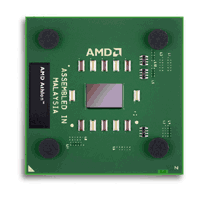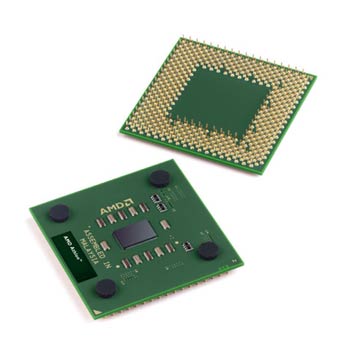The AMD
AthlonXP Thoroughbred Processor
 AMD's long awaited AthlonXP "Thoroughbred" processor (aka T-Bred)
has finally arrived. Built on 0.13 micron technology the T-Bred will run
cooler then any Athlon/XP that proceeded it and allow AMD to ramp up the clock
speed of their processors higher. Will this allow the AthlonXP to
take back the speed crown from AMD's arch rival Intel and
their Pentium 4 processors?
AMD's long awaited AthlonXP "Thoroughbred" processor (aka T-Bred)
has finally arrived. Built on 0.13 micron technology the T-Bred will run
cooler then any Athlon/XP that proceeded it and allow AMD to ramp up the clock
speed of their processors higher. Will this allow the AthlonXP to
take back the speed crown from AMD's arch rival Intel and
their Pentium 4 processors?
It's no secret that AMD lags behind Intel quite a
bit in terms of pure MH
z. However since the release of the
Pentium 4, MHz or GHz is no longer a good indication
of how fast a CPU is, since the Pentium 4 does quite a bit less work
per clock cycle then an Athlon based CPU. The former top of the line AMD processor,
the AthlonXP 2100+ (1.73 GHz) Palomino could often out perform a Pentium 4 2.0
GHz (Williamette or
Northwood) despite having a 270 MHz clock speed disadvantage, and can even give
a healthy challenge to Pentium 4's running at 2.4 GHz+ in most
benchmarks.
Now with
the smaller T-Bred officially out, AMD can ramp up the speed of their processors
which badly needed a boost in raw MHz. The top end chip, the AthlonXP 2200+
officially runs at 1.8 GHz and still uses the 133/266 MHz FSB we've all become
accustomed to. All T-Bred based cores are built
at AMD's FAB 30 in Dresden Germany and still resides in the ever familiar Socket
A we're all use to. The actual architecture of the T-Bred is no different then
the larger 0.18 micron Palomino cores so clock for clock the cores are the same
speed. The T-Bred is not only an exclusively top end processor
either. It will run at various speeds the slowest, being 1700+ (1.46 GHz).
The actual transistor count has been decreased from
37.5 million to 37.2 million thanks to more efficient design and layout as well
as lower voltage handling requirements. The T-Bred core is quite small at only
80mm2 compared to 128mm2 (Palomino) and 145mm2 (131mm2 for the 2.4 GHz+) Pentium
4 Northwoods. In terms of cooling, any heatsink/fan combo that can keep an
Palomino XP2000+ or XP2100+ can cool the T-Bred processor as well.
Motherboards that support the older Palomino
processors only need a simple BIOS update that to allow them to use the new
T-Bred CPU's which is quite nice for ease of mind.
Processor
Model |
Operating
Frequency
(MHz) |
Nominal
Voltage |
Typical
Thermal
Power |
Maximum
Thermal
Power |
Typical
Current
Working
State |
Max
Current
Working
State |
Typical
Current
in
Stop
Grant |
Max
Current
in
Stop
Grant |
| 1700+ |
1467 |
1.50V |
44.9W |
49.4W |
29.9A |
32.9A |
2.8A |
4.5A |
| 1800+ |
1533 |
46.3W |
51.0W |
30.9A |
34.0A |
| 1900+ |
1600 |
47.7W |
52.5W |
31.8A |
35.0A |
| 2000+ |
1667 |
1.60V |
54.7W |
60.3W |
34.2A |
37.7A |
3.3A |
5.4A |
| 2100+ |
1733 |
56.4W |
62.1W |
35.2A |
38.8A |
| 2200+ |
1800 |
1.65V |
61.7W |
67.9W |
37.4A |
41.2A |
3.6A |
5.9A |
As we can see the 1700+-1900+ models will run at a VCore
of 1.5V however to allow the T-Bred to run stability at 2000 and 2100+ speeds
the voltage has been raised slightly to 1.6V. At 2200+ they need yet more voltage,
1.65V! It seems AMD might be having a few problems
with their manufacturing process since they're using an old overclockers
trick (higher voltages) to reach the higher speeds! From what we've seen online
as well, the T-Bred core has quite a bit to mature since the current test models
aren't very overclockable.
In terms of architecture the T-Bred has all the
familiar technology that comes with the Palomino, the biggest being Data
Prefetch and Intel's SSE technology. Data prefetch allows the processor to
look at data patterns and try to predict what information is needed next.
After the "guess" is made, the information needed is brought to the CPU's
cache via the main memory. Intel's SSE (Streaming SIMD Extensions) debuted about
three years ago now with the release of their Pentium 3 line of processors.
Intel pushed long and hard for software developers to adopt SSE into their
programs and because more software was using Intel's special code rather then
AMD's 3D Now! (competing technology), AMD decided to license SSE from Intel.
This was a smart move on AMD's part since Intel has more clout then they do they
can just let Intel do all the work.
We are as guilty as everyone else on
the net thinking that the T-Bred would bring AMD back into the forefront
of performance. The T-Bred is really only a Palomino on a 0.13 micron manufacturing
process and really doesn't offer anything new. Only till the Barton comes out later this
year will we see an actual boost in clock for clock performance for Athlon based
processors. The T-Bred is not AMD's saviour, however they are betting that
the T-Bred and with the Barton later this year is enough to hold down the fort
till they can release their Hammer line of CPU's.

Contents of Article: AMD AthlonXP
|
|
|
|
|

